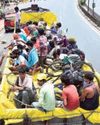
United States President Donald Trump was convinced that the coronavirus was just common flu. On March 4, he told the television host Sean Hannity that the coronavirus was not even as lethal as the flu, which could kill between 27,000 and 77,000 people a year. A week later, Dr Anthony Fauci of the National Institutes of Health told the U.S. Congress that “the mortality of COVID-19 is multiple times what the seasonal flu is”. The death rate for the flu is 0.1 per cent, while the World Health Organisation (WHO) says that the estimated death rate for coronavirus is at 3.4 per cent. This small incident reveals how callous Trump was from the very first about the coronavirus and the threat it posed to the people of the world, and to the people of the U.S.
Not only was Trump publicly callous about the threat from this coronavirus, but his administration had cut funding for the Infectious Diseases Rapid Response Reserve Fund and for the Centres for Disease Control and Prevention (CDC). The CDC lost 15 per cent of its budget, which amounts to $1.2 billion, while the Reserve Fund lost $35 million. The federal Public Health Emergency Preparedness programme lost a third of its budget between 2002 and 2019, now down to $617 million; this has meant a loss of trained workers who can manage a pandemic at the community level. These cuts come after a decade of austerity for public health services in the U.S. and the haemorrhaging of workers in the social services and public health sectors. The infrastructure that would deal with a pandemic had been sliced down to the bone, or indeed, even into the bone.
This story is from the April 10, 2020 edition of FRONTLINE.
Start your 7-day Magzter GOLD free trial to access thousands of curated premium stories, and 9,000+ magazines and newspapers.
Already a subscriber ? Sign In
This story is from the April 10, 2020 edition of FRONTLINE.
Start your 7-day Magzter GOLD free trial to access thousands of curated premium stories, and 9,000+ magazines and newspapers.
Already a subscriber? Sign In

How Not To Handle An Epidemic
The lockdowns were meant to buy time to put in place appropriate health measures and contain the coronavirus’ spread, but they have failed to achieve the objective and heaped immense misery on the marginalised sections of society. India is still in the exponential phase of the COVID-19 infection and community transmission is a reality that the government refuses to accept.

Tragedy on foot
As the COVID-19-induced lockdown cuts the ground beneath their feet in Tamil Nadu, thousands of migrant workers are trudging along the highway to the relative safety of their upcountry homes.

Sarpanchs as game changers
Odisha manages to keep COVID-19 well under control because of the strong participation of panchayati raj institutions and the community at the grass-roots level under the leadership of Chief Minister Naveen Patnaik.

Scapegoating China
As the COVID-19 death rate spikes and the economy tanks in the United States, Donald Trump and his advisers target China and the World Health Organisation with an eye to winning the forthcoming presidential election.

New worries
Kerala’s measured approach to the pandemic and lockdown has yielded results. But it still has to grapple with their huge economic impact on its economy, which it feels the Centre’s special financial relief package does little to alleviate.
No love lost for labour
Taking advantage of the lockdown and the inability of workers to organise protests, many State governments introduce sweeping changes to labour laws to the detriment of workers on the pretext of reviving production and boosting the economy.

Capital's Malthusian moment
In a world that needs substantial reorienting of production and distribution, Indian capital is resorting to a militant form of moribund neoliberalism to overcome its current crisis. In this pursuit of profit, it is ready and willing to throw into mortal peril millions whom it adjudicates as not worth their means—an admixture of social Darwinism born of capital’s avarice and brutalism spawned by Hindutva. .

Understanding migration
When governments and their plans are found to be blatantly wanting in addressing reverse migration, exercises such as the Ekta Parishad’s survey of migrant workers throughout India can be useful to work out creative long-lasting solutions.

Waiting for Jabalpur moment
The Supreme Court’s role in ensuring executive accountability during the ongoing lockdown leaves much to be desired. Standing in shining contrast is the record of some High Courts.

An empty package
The Modi regime, which has been unable to control the COVID-19 infection, restore economic activity and provide relief to millions exposed to starvation, trains its sights on Indian democracy, making use of the panic generated by fear and a lockdown that forecloses paths of resistance.